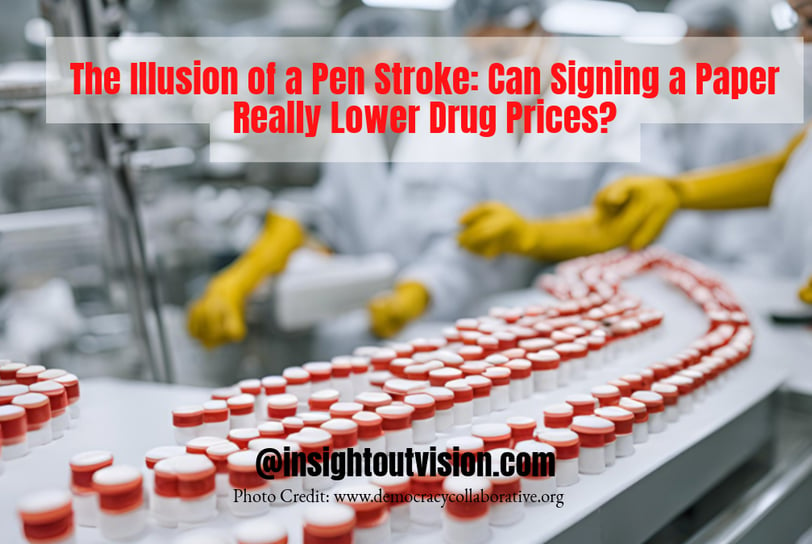The Illusion of a Pen Stroke: Can Signing a Paper Really Lower Drug Prices?
5/13/20253 min read


The Illusion of a Pen Stroke: Can Signing a Paper Really Lower Drug Prices?
Category: Deep Dive
Sub-category: Behind the Headlines
In a world where healthcare costs are a perennial concern, the promise of lowering drug prices with the stroke of a pen sounds almost magical. Yet, as recent political rhetoric and executive actions suggest, the reality is far more complex. The White House's recent X post, highlighting President Trump's executive order to reduce drug prices by aligning them with international standards, has sparked a debate. But can such a measure truly deliver, or is it more smoke and mirrors? Let's dive behind the headlines to unpack this issue.
The Bold Claim: A Signature for Savings
The executive order in question, signed by President Trump, aims to lower prescription drug costs by benchmarking prices against those in other countries and promoting competition through generic and biosimilar medicines. The White House's post criticizes previous Democratic leaders for failing to act decisively, contrasting their words with Trump's purported actions. But here's the rub: signing a piece of paper doesn't inherently change the market dynamics of drug pricing. It's a starting point, not a solution.
Drug prices are influenced by a myriad of factors, including research and development costs, patent protections, regulatory environments, and global supply chains. An executive order can set a policy direction, but its effectiveness hinges on implementation, compliance, and the willingness of other nations to play ball. The order proposes tying U.S. drug prices to international benchmarks, but what if those countries decide not to sell their drugs to America anymore? With 200 other countries in the world, the U.S. might find itself in a precarious position.
The Global Chess Game: What If Other Countries Walk Away?
Imagine a scenario where countries like Canada, the UK, or Germany, which often have lower drug prices due to different healthcare systems and negotiation powers, decide that selling drugs at reduced rates to the U.S. is no longer in their interest. They might prioritize their own citizens or seek better deals elsewhere. This isn't just a hypothetical; it's a real risk. Pharmaceutical companies, facing pressure from both sides, might choose to redirect their exports, leaving the U.S. market short on supply.
The consequences could be dire. Without access to these drugs, American patients might face shortages, driving up costs even further due to scarcity. Moreover, the U.S. reliance on imported drugs means that disrupting these supply chains could have ripple effects across the healthcare system. Hospitals, pharmacies, and patients would all feel the pinch, potentially exacerbating the very problem the executive order seeks to solve.
The Broader Implications: A World of 200 Other Countries
The U.S. is not an island. In a globalized economy, trade relationships are intricate and interdependent. While there are indeed 200 other countries to trade with, not all of them have the capacity or willingness to fill the gap left by traditional suppliers. Many of these countries lack the infrastructure, regulatory standards, or production capabilities to meet U.S. demand for pharmaceuticals. Others might impose their own trade barriers or demand concessions that could be politically or economically unpalatable.
Furthermore, the pharmaceutical industry is highly specialized. Drugs are not interchangeable commodities; they require specific manufacturing processes, quality controls, and distribution networks. Shifting to new suppliers could introduce delays, increase costs due to logistical challenges, and potentially compromise safety and efficacy. The U.S. would need to invest heavily in domestic production, a move that could take years and billions of dollars, all while navigating the political and economic fallout of such a shift.
The Realpolitik of Drug Pricing
Behind the headlines, the reality is that drug pricing is a chess game played on a global board. Executive orders can set the stage, but they don't dictate the moves of other players. The Inflation Reduction Act, passed under the Biden administration, gave Medicare the power to negotiate drug prices, a move that has already shown promise in reducing costs for specific medications. However, even this legislative approach faces challenges, including legal battles and the slow pace of change.
Trump's executive order, while bold in its intent, relies on voluntary compliance and regulatory action that may not materialize as hoped. The pharmaceutical industry, with its deep pockets and influential lobby, is unlikely to roll over without a fight. Legal challenges, market resistance, and international retaliation could all undermine the order's effectiveness.
Thought Questions for Readers
Policy vs. Practice: How much weight should we give to executive orders versus legislative reforms when addressing complex issues like drug pricing?
Global Interdependence: In a world of 200 countries, how can the U.S. balance its healthcare needs with international trade dynamics?
Short-Term Gains vs. Long-Term Risks: Is the potential for immediate cost reductions worth the risk of long-term supply chain disruptions?
Explore deep insights on current events and growth.
Vision
Truth
hello@insightoutvision.com
+1-2236036419
© 2025. All rights reserved.
